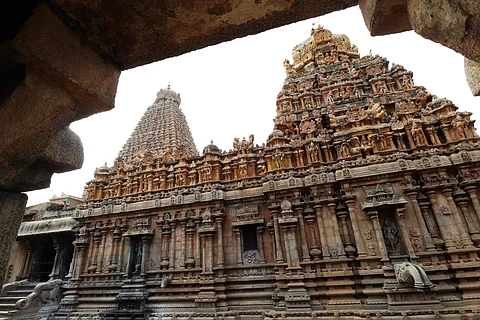

ISTOCK
If history had a treasure chest, Tanjore would be one of its brightest jewels. Tucked away in the lush Cauvery Delta of Tamil Nadu, this ancient city seems to wear time like an ornament — not hidden away, but proudly displayed in every temple wall, bronze statue, and rhythmic beat of its traditional music. Here, the past is never just in books; it spills onto the streets, mingling with the aromas of filter coffee and jasmine flowers.
Long before skyscrapers and highways, Tanjore was already a place of grandeur. Over a thousand years ago, it was the capital of the mighty Chola dynasty — one of the greatest empires in Indian history. The Cholas were master builders, skilled artists, and bold rulers, and they left behind more than palaces and battle tales. They gave Tanjore its identity as a centre of culture, art, and devotion.
The city’s crown jewel is the Brihadeeswarar Temple, a UNESCO World Heritage site and a masterpiece of Chola architecture. Built by the legendary King Raja Raja Chola I in the 11th century, it rises like a stone mountain from the flat delta plains. Its towering vimana (temple tower), carved from granite, is so tall that it casts almost no shadow at noon. Step inside and you’ll find walls covered in centuries-old frescoes, colossal sculptures of Nandi the bull, and an atmosphere that feels both sacred and timeless. The scale is mind-boggling, especially when you remember it was built without the modern machines we take for granted today.
But Tanjore’s magic doesn’t stop at its temples. For centuries, it has been home to exquisite bronze casting, a craft perfected under the Cholas. These bronzes — often depicting Hindu deities — are not just works of art; they are so lifelike that they seem ready to step off their pedestals. The skill has been passed down from generation to generation, and artisans here still use the ancient lost-wax technique, just as their ancestors did a thousand years ago.
The city is also famous for Tanjore painting, a style instantly recognisable by its rich colours, intricate details, and use of gold foil. Originally created for temple art, these paintings often depict gods and goddesses framed in ornate arches. Even today, artists in Tanjore keep the tradition alive, balancing centuries-old methods with modern creativity.
And then there is the music. Tanjore is considered the cradle of Carnatic music, one of the oldest systems of classical music in the world. It was here that legendary composers like the Trinity of Carnatic music — Tyagaraja, Muthuswami Dikshitar, and Syama Sastri — lived and created compositions that are still sung in concerts across the globe. During temple festivals, the air fills with the sounds of the nadaswaram (a traditional wind instrument) and the rhythmic beats of the mridangam. Music here isn’t just entertainment; it’s a way of life.
Life in Tanjore flows at an unhurried pace. Mornings begin with the ringing of temple bells and the smell of hot idlis steaming in brass cookers. Street markets brim with colourful flowers, gleaming brass vessels, and ripe bananas stacked in neat pyramids. Farmers bring in fresh produce from the surrounding delta, known as the “Rice Bowl of Tamil Nadu,” while shops display handwoven silk sarees whose patterns seem to tell their own stories.
If you wander beyond the city, the landscape changes to emerald-green paddy fields, crisscrossed by canals fed by the Cauvery River. Coconut palms sway lazily, and you might spot farmers using traditional bullock carts alongside modern tractors — a reminder that in Tanjore, the old and the new live side by side.
Festivals are when Tanjore truly bursts into life. The annual Natyanjali Dance Festival, dedicated to Lord Nataraja, brings dancers from all over India to perform in the temple courtyard. During Pongal, the harvest festival, houses are decorated with kolams (intricate rice-flour patterns), and sweet dishes made from newly harvested rice are shared with neighbours. These celebrations are as much about community as they are about tradition.
What makes Tanjore special is how effortlessly it blends grandeur and warmth. It’s a place where you can stand in awe before a thousand-year-old temple in the morning, watch an artist paint delicate gold details on a canvas in the afternoon, and listen to a raga drifting through the night air. It is living proof that history is not just about what has been — it is about what continues to be.
You can trace your fingers over ancient inscriptions one moment and snap photos for Instagram the next. The city’s stories, carved in stone and sung in melodies, are waiting for anyone curious enough to explore them.
And perhaps that’s the greatest gift Tanjore offers — the realisation that heritage is not something frozen in museums. It’s something you can taste in its food, hear in its music, and see in the smiles of its people.
At noon, the Brihadeeswarar Temple’s towering vimana casts almost no shadow on the ground — an architectural wonder from over a thousand years ago.
The temple’s vimana rises about 66 metres high, built entirely from granite, even though no granite quarry exists nearby.
Tanjore dancing dolls are traditionally made from a combination of materials including clay, paper mache, plaster of Paris, and tapioca flour.
ISTOCK
Tanjore bronzes are made using the ancient lost-wax casting method, a craft that has remained unchanged for over a millennium.
Tanjore paintings are adorned with delicate gold foil, giving them a rich, glowing look that lasts for generations.
The Cauvery Delta surrounding Tanjore produces such abundant paddy harvests that the region is called the “Rice Bowl of Tamil Nadu.”
Colorful paintings on ceiling wall of Darbar Hall of the Thanjavur Maratha Palace.
ISTOCK
Tanjore is considered one of the birthplaces of Carnatic music traditions, many of which are still practised and celebrated today.